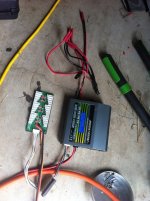Syonyk said:
but lipo packs are far and away the most likely to catch fire.
That statement doesn't completely cover the problem/solution(s):
If the packs were monitored and limited (charge *and* discharge LVC/HVC at cell level, thermal monitoring, etc), and were physically built with proper care to wiring them up (so wires don't get pinched or damaged in other ways), the likelihood of fires would be lower--probably much much lower.
For the many that don't simply bulk charge, if the packs were not disassembled and reassembled (at least in the wiring) for charge vs discharge, this would probably help the wiring issues at least some, and would also prevent the fires that happen because of stuff being plugged back in incorrectly.
If some sort of containment were used (beyond duct tape and nylon bags

) then those fires that do happen anyway would be less likely to spread to their surroundings. Especially if such containment were done in a way that keeps the packs separated from each other enough to keep one from setting the next on fire. (including fusing between the packs on main and balance wires so that if one melts wires together for whatever reason, it won't short the other packs out).
Unfortunately any chemistry could fail dramatically and suddenly, from internal defects, even if the charge/discharge process is always normal and monitored to never go "out of bounds". So all of the above suggestions could help any of them in that event.
Since:
------The RC LiPo packs (based on infant-mortality failure rates seen around here, including spontaneous fires such as the one John in CR had some time back with a pack just sitting loose) are probably generally manufactured with a lower QC level than most of the other stuff we use on ebikes,
AND:
------The cheaper the packs are, the more likely the above probably is,
AND:
------The cheaper the packs are, the more likely people (especially noobs) building ebikes are to buy those for their packs,
AND:
------The newer someone is at this, the less likely it is they're going to bother with any of the precautions until it is too late to worry about anymore (and the more old-hat it is to experienced people, sometimes the more complacent they become),
Then it seems that more of these problems are likely to happen.
Stopping the use of RC LiPo isn't going to happen, unless they simply stop making the packs.

They *can* be safe enough to use, given the right QC, precautions, containment, etc.
The other whole issue is...none of us really knows what the root cause of most of the fires we've seen has been. We can guess, based on information reported, but usually very little info is ever given, even out of what little the person that experienced it usually has (most don't seem to care much beyond being upset at the loss of the pack or the bike...some are affected deeply because they lost their house or other things/etc, but they also don't typically provide any real information about the actual failure).
I can't recall any of those that reported fires on ES that ever did much failure analysis of the fire, though there is often a lot of semi-educated speculation, mostly by readers of the thread.

So, the reality is that we don't know which of the various things:
--wiring
--quality
--chemistry
--charging care
--monitoring
--cell age
--discharge depth
--etc.
are really factors in the fires, and which were just contributors to keeping them going once started, or had nothing to do with them.
I've spent a fair amount of time being paranoid about what could and couldn't cause a fire, and how to prevent one, not just in batteries but in everything else possible, since losing my dogs to a house fire (unrelated to ebikes/batteries/etc) a little over 2 years ago.
I've considered a lot of what's been said about battery fires here on ES, and AFAICT most of the real root cause of them is carelessness by the builder and/or user of the battery, because:
--if the battery had been built with fuses to prevent shorts from heating anything up, some of the suspected wiring fault fires would never have happened.
--if the battery had been monitored for voltage (and preferably temperature) at cell level, preferably with automated cutoffs, for both charge and discharge, some of the suspected imbalance/overcharge/overdischarge fires would never have happened.
--if the battery had been built to separate the packs (firewall them) in case one did light up for whatever reason, and contain that fire within the battery casing, some of the fires that happened anyway woudln't have been as bad as they were.
Beyond that....I decided a while ago that I don't want to acquire any more RC LiPo packs unless it is for the destructive tests to help test out the various hypotheses of fire prevention and containment. Presently I have enough problematic ones to do that with, once I get around to it.
If I had a known good containment system, and known working prevention methods, I'd probably feel differently, but at present I just don't trust the actual manufacturer QC enough to build them into my bikes (which get parked inside the house, mostly), even if I do all the monitoring, checking, wiring setup, etc.
Note that I'm extra paranoid, in that I don't really trust *any* battery, as I keep everything with rechargeable batteries in it either at-hand (like my celphone) or inside a containment system. Even the laptop doesn't have it's battery actually in it unless I intend to use it portably.

The ebikes have their batteries inside vented ammocans (even though they are EIG NMC for CB2, and A123 prismatic for SBC). That containment isn't *tested* and *proven* to work, but it should...and at present that has to be good enough for me on those "trustable" packs, because I can't afford to destroy one of each inside it's containment to verify it.

So while I am not the typical RC LiPo user, I *would* use it if I knew that whatever I did to it it still couldn't cause a fire outside the single pack that happens to fail.



